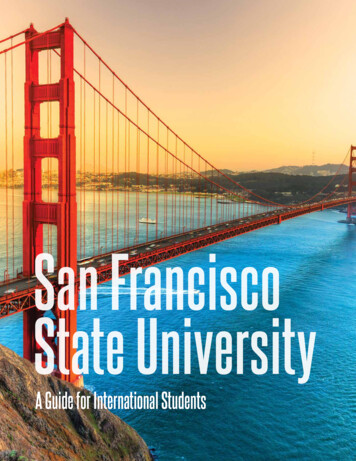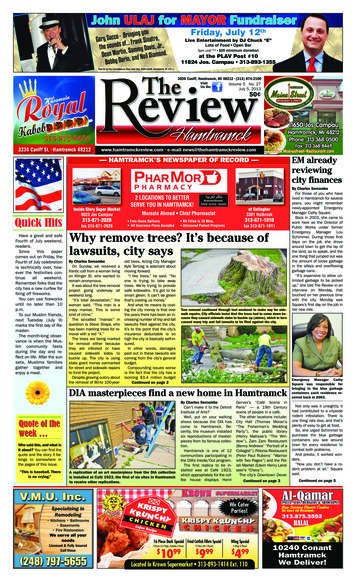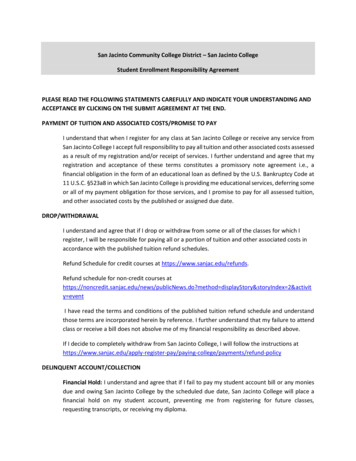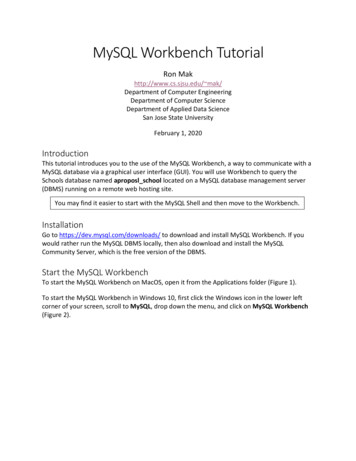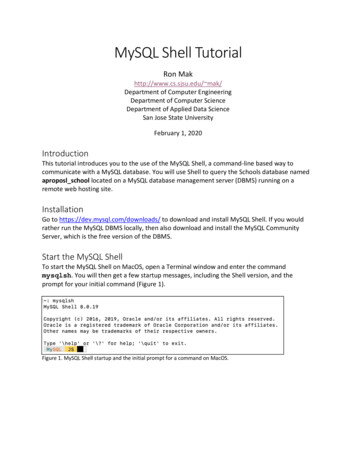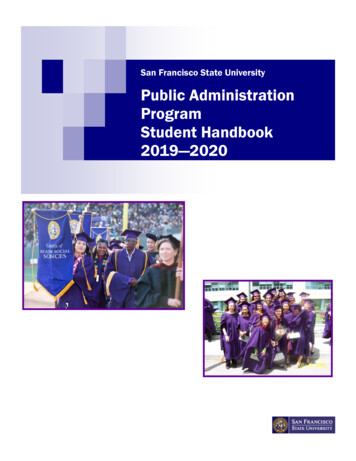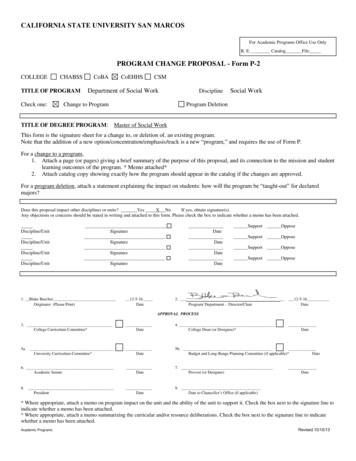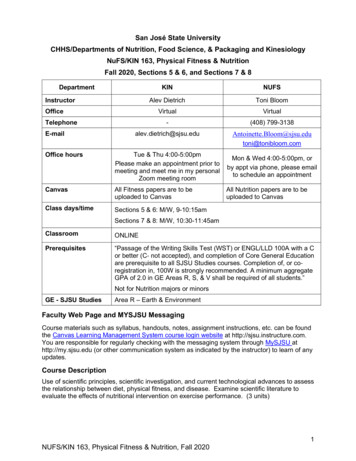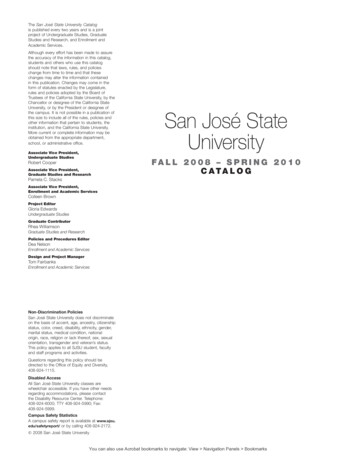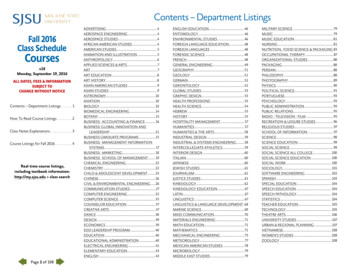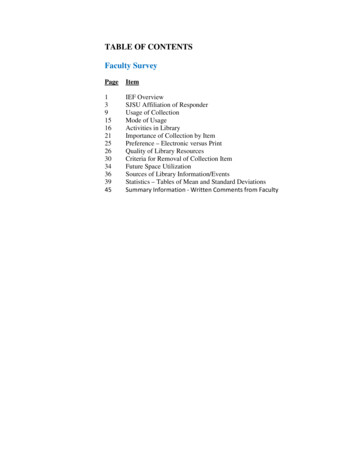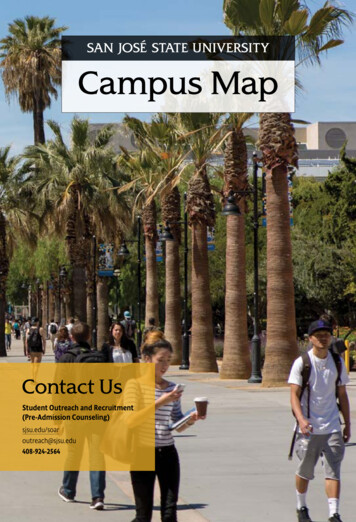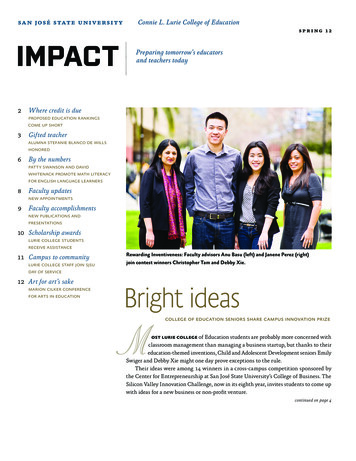
Transcription
San José State University Connie L. Lurie College of Educations p r i ng 1 2Preparing tomorrow’s educatorsand teachers today23689Where credit is dueproposed education rankingscome up shortGifted teacherAlumna Stefanie Blanco de WillshonoredBy the numbersPatty Swanson and DavidWhitenack promote math literacyfor English language learnersFaculty updatesNew appointmentsFaculty accomplishmentsNew publications andpresentations10 Scholarship awardsLurie College studentsreceive assistance11 Campus to communityLurie College staff join SJSUday of service12 Art for art’s sakeMarion Cilker Conferencefor Arts in EducationRewarding Inventiveness: Faculty advisors Anu Basu (left) and Janene Perez (right)join contest winners Christopher Tam and Debby Xie.Bright ideasCollege of Education Seniors Share Campus Innovation Prizeost Lurie College of Education students are probably more concerned withclassroom management than managing a business startup, but thanks to theireducation-themed inventions, Child and Adolescent Development seniors EmilySwiger and Debby Xie might one day prove exceptions to the rule.Their ideas were among 14 winners in a cross-campus competition sponsored bythe Center for Entrepreneurship at San José State University’s College of Business. TheSilicon Valley Innovation Challenge, now in its eighth year, invites students to come upwith ideas for a new business or non-profit venture.continued on page 4
from the DeanThe articles in this issue of Impact focus on the efforts made by individuals toimprove the lives of others. SJSU’s Day ofService demonstrates the university’s commitment to our local neighborhoods, forexample, while the undergraduate winnersof the Silicon Valley Innovation Challenge,Emily Swiger and Debby Xie, used theirtalents and energy to design products thatgive children greater access to education.Our featured alum, Stefanie Blanco deWills, chose to become a teacher becauseshe wanted to help her community, anorientation that continues to inform herwork with her colleagues at James LickHigh School.2 impactProfessors Patty Swanson and DavidWhitenack provide extensive professionaldevelopment to help local teachers teachmath to English Language Learners. I applaud the work of these individuals, because they represent the Lurie College’scommitment to service for the greater good.While we can feel inspired by theseindividual efforts to do the right thing forour communities, I worry that our societyhas given up on taking more collective action to improve the lives of young people.Each year schools at all levels feel theeffects of budget cuts. Class sizes have increased. School facilities continue to deteriorate. Report after report documentshow educational achievement in Americafalls further behind that in other countries.Proposed solutions fall on different sidesof familiar political and ideological divisions. We seem incapable or unwilling toagree on what the problem is, much lesshow to fix it.A recent book entitled Justice: What’sthe Right Thing to Do? by Michael Sandel,presents an insightful analysis about whypolitical discourse in our nation has beenreduced to polemics and sound bites ratherthan true dialogue and engagement.Sandel teaches a wildly popular classat Harvard on political philosophy. If youread his book, you’ll know why he attractsso many students. His central argument isthat we need to define for ourselves whatconstitutes the “common good” if we are tomake any headway in solving problems insociety. That is, the public needs to debateconnie l. lurie college of educationwhat we mean by morality in civic life ifwe are to achieve a just society.Sandel provides a nuanced accountof what he means by moral values andacknowledges that there are bound to bedisagreements: “There is no guarantee thatpublic deliberation about hard moral questions will lead in any given situation toagreement —or even to appreciation forthe moral and religious views of others.”The students, alums and faculty highlighted in this issue seem to be motivatedby an ethic of care or sense of moralityand social justice. As a College, we do notshirk from preparing our future educatorsto engage in such discussions to developthe dispositions of the heart and mind thatwill tend toward the greater good.And that is why we will have no dearthof stories like the ones in this issue.Elaine Chin, Deancoe-edimpact-group@sjsu.edu
Classroom dynamoAlumna Stefanie Blanco de WillsReceives Teaching Honorrowing up in Salinas, Calif.,where her Mexican-American forebears had worked for generations asagricultural workers, Stefanie Blanco deWills knew from an early age exactly whatshe wanted to do with her life.“I always wanted to be a teacher,” shesays. “ I had the concept I wanted to helplittle kids. I wanted to help my community.”Now on the faculty at James Lick HighSchool in San José’s East Side Union HighSchool District, Blanco de Wills, 28, hasbeen recognized as a Santa Clara CountyTeacher of the Year.Last Sept. 27, she and 30 other areateachers gathered for the 42d annualTeacher Recognition Celebration at theCampbell Heritage Theatre co-hosted byCharles Weis, the Santa Clara Countyschools superintendent, and local television news anchor Jessica Aguirre.“I don’t think I knew what a big honorit was,” Blanco de Wills says (although theice sculptures and the packed auditoriumshould have been a clue). “I definitely felttreasured as a teacher.”But she also sees the award as an acknowledgement of the hard work of herfellow teachers at James Lick. “I felt like itwas more of a collaboration for all of us,”she says. “I know how hard we work andhow hard the students work. It goes backto the family. It’s ‘We,’ not ‘I.’”Blanco de Wills’ passion for teachingcomes from her family. Her mother was afirst-grade teacher, and her grandmother,now in her 90s, taught Head Start. They provided, she says, “a very strong female presence. It’s a very strong matriarchal model.”After high school, Blanco de Willsstudied history at California PolytechnicState University in San Luis Obispo—andbecame the first in her family to graduatefrom a four-year college. Then it was on toSan José State University, where she earneda teaching credential in social sciences anda master’s degree in administration in theLurie College of Education.“I had some amazing professors,” shesays. “It was a very grounding and helpful program.” Among the faculty memberswho stood out was Mark Felton, chair ofthe department of secondary education,she says.Blanco de Wills wound up teaching atJames Lick after her car broke down whileshe earned her teaching credential and shestarted relying on public transportation toget to work.She thinks it is a good fit. “I come froma very similar background to the studentsthat I work with,” she says. Blanco de Willsis proud that James Lick has been recognized as one of the most-improved schoolsin Santa Clara County over the past threeyears.She maintains a busy classroom schedule, teaching world history, U.S. history,AP world history sociology and psychology, among other subjects. She is part ofan initiative at her school to help her colleagues come up with strategies to helpfailing ninth-graders.She also serves as the advisor for the academic club, which helps students preparefor standardized tests, the Leos, the youthaffiliate of the Lions Clubs Internationaland the student Gay-Straight Alliance.An avid runner, Blanco de Wills somehow manages to find the time to coach herschool’s formidable girls’ cross-countryteam, a commitment that also includeshelping the runners fundraise so they cantravel to their meets. “We’ve made it consecutively to the league championships for22 years,” she says matter-of-factly.Despite her busy schedule, she says shehas no plans to slow down. “Giving back ispart of being a teacher,” she says. /san josé state universityspring 20123
Bright ideas, continued from page 1Last fall, 100 students submitted theirentries, which were mounted on standardsized poster boards. The boards were setup for display during a daylong judgingsession held last Dec. 1 in the Ron BarrettBallroom in the Student Union.Swiger’s entry, Talk to Me, an interactive method that promotes communication skills in autistic children, and Xie’sePrepared, an all-in-one website aimed athelping students navigate the college application, curriculum and financial aidprocess, tied for first place in the socialinnovation category. It was the first timeLurie College students had won an awardin the competition.“I screamed—I was probably inappropriate,” recalls Janene Perez, a lecturer inChAD who helped organized the innovation challenge and was on hand when thewinners were announced. “I thought I wasgoing to cry, I was so excited.”Perez had urged her students—Swigerand Xie among them—to enter the competition, sweetening the deal with the promise of extra credit. She helped both studentsperfect their entries beforehand.“I saw judges repeatedly go over to theirbooths,” she says. “To get the two tied forfirst place—I was overjoyed.”Anuradha Basu, director of the Center for Entrepreneurship in the Collegeof Business, launched what she originallycalled the “Neat Ideas Fair” in 2004 whenshe arrived at San José State after a careerin business and education spent mainlyin India and the United Kingdom. Mostof the original participants were businessmajors, she says, but in time, it becameapparent that the net needed to be castmore widely.“For successful innovation, one reallyneeds students from different disciplinesto get together and learn from each other,”she says. “The question became how do weget students from different disciplines toget together?”4 impactWith the support of the university’sadministration, a campus-wide organizingcommittee drew faculty from each of thecolleges (Perez represented the Lurie College of Education), Basu says.This year’s competition drew 25 volunteer judges from local businesses and theuniversity’s alumni pool, she says. SomeSilicon Valley businesses also provided financial and in-kind support.Prizes were awarded in a variety of categories, including the best overall innovation, clean tech, a “people’s choice” awardand social innovation. The overall winnerwas J.D. Leadam, a business administration major, who came up with an idea fora hemp plastic water bottle.Meanwhile, some students developed a“90-second elevator pitch,” which requiredthat they distill the high points of theirpresentation into a concise oral summation.“This gives an opportunity for the studentsto build their self-confidence,” Basu says—although students usually are resistant tothe idea at first. “When they do it, they say,‘Thank you, professor.’”The boy is completely nonverbal andmanipulates icons on a touch-screen deviceto express his basic needs, she says. “That’swhat got me interested in the communications side of special education.”Despite his deficits, Swiger was convinced that the boy was “really intelligentin other ways” and started thinking abouthow his communication abilities might beenhanced using an icon-based system.Although she lacks technical skills, sheenvisions Talk to Me as an iPad-like device(or even a collection of iPad apps) thatcould provide autistic kids with a systemof activities to help induce communication.Swiger thinks the suite of games and activities would actually enable the children toacquire new vocabulary, leading to richerinteractions with caregivers and other children. For her innovation challenge entryshe fashioned a prototype that used Velcroicons to demonstrate her idea.Swiger says she drew some inspirationfrom the SMART Table, a touch-screen interactive device for elementary school students that Perez had in her classroom lastFor successful innovation, one really needs studentsfrom different disciplines to get togetherand learn from each other.—Anuradha BasuSwiger, a senior who studied accounting at a community college and worked at abank before transferring to San José State,comes by her interest in helping autisticchildren communicate through first-handexperience: her older sister is autistic, andSwiger herself has worked as a behavioralinterventionalist with a 9-year-old boy inthe Franklin-McKinley school district.connie l. lurie college of educationsemester. Swiger and others in the classspent time developing simple game apps forthe SMART Table as part of their training.Meanwhile, she decided to take on thechallenge of developing a 90-second elevator pitch to promote her invention—andshe’s glad she did. “It was intimidating, because there’s not a lot of awareness aboutautism,” she says. “What is autism? What
Competing Ideas: Business professor Anu Basu (above) at the SiliconValley Innovation Challenge student fair. Lurie College senior EmilySwiger (right) explains her Talk to Me project to contest judges.are the challenges? What is the icon system? I had to write it out word for wordand remember it exactly.”Swiger, who enrolled at San José Stateas a business major before switching toChAD with the aim of working in specialeducation, now wants to pursue a graduate degree in Communicative and SpeechDisorders so she can focus on helping autistic children.As a student at Piedmont Hills HighSchool in San José’s East Side Union HighSchool District, Debby Xie became friendswith Christopher Tam, a whiz at onlinemarketing and search-engine optimization.Both share dual majors in business, but Xieis also in education, while Tam’s secondmajor is in communications studies. Theyalso shared the experience of being the firstones in their family to attend a four-yearuniversity—and both have younger siblingswho are applying to college.Xie, whose parents primarily speakChinese, were supportive of her academicgoals, but were unable to provide muchguidance as she went through the collegeapplication process. “I was kind of left onmy own—to do it myself,” she says.Finding herself counseling her youngerbrother about applying to college, Xie decided to collaborate with Tam in developing a website to provide all-in-one information for college-bound young people frombackgrounds like theirs. “We had in mindthat we wanted to do something involvingsociety and education,” she explains. “Welooked back to high school.”Their ePrepared website (www.ePrepared.net) aims to get high school studentsto stay in school while helping them select a curriculum that will improve theirchances of winning college admission.When the website is fully active, it willalso include videos, practice questions andguidelines for parents that explain collegeentrance exam requirements and provideother helpful tools. It will also offer chartsand checklists to help students keep trackof what they need to do to complete theadmissions process.The pair plan to keep the website nonprofit, Tam explains, “Because we’re doingthis from our own experience and want tohelp.” If they succeed in attracting funding,they hope to pay teachers to write collegebound curriculum that can be posted onthe site.Xie credits Perez with mentoring herand Tam as they developed their idea. “Shewas really excited,” Xie says. “She helped usachieve something we wouldn’t have beenable to achieve otherwise.”Basu says students who enter the innovation challenge are also encouraged toenter the spring semester’s business-plancompetition, which is aimed at actuallybringing their new ideas to market.Perez meanwhile looks forward tocontinuing her involvement with the innovation challenge—and urging her classesto participate. “The more students try tocreate something for this challenge, themore they will find something that resonates for them,” she says. “This is a greatway for them to combine their passion withinnovation and see it come to life.” /san josé state universityspring 20125
Too many words to countBoosting math literacy forenglish language learnersost of us can recall fromour own school days the challenges math word problems posefor students as they struggle to translateconvoluted sentences into solvable equations—but research has shown these difficulties are amplified for English languagelearners.In fact, language is such a big part ofmastering mathematical concepts in upperelementary and middle school grades thatwhen looking at how students perform onstandardized test scores, “You can almostpredict the math score with their languagescore,” says Patricia Swanson, an associateprofessor of elementary education.Swanson and David Whitenack, a fellow elementary education professor in theLurie College of Education, have spent6 impactthe past several years figuring out howto improve math instruction for Englishlanguage learners, focusing primarily onoffering teachers new strategies for imparting concepts to their students.The pair are part of a consortium thatrecently won a five-year 1.97 million federal grant to train future teachers to better present math, science and social studiesconcepts and vocabulary to students whoare falling into a widening achievementgap. Nationally, for example, 70 percentof English language learners haven’t mastered basic math skills by eighth grade.“When you look at how math is taught,”Swanson says, “You learn our curriculumis a mile wide and an inch deep.”Meanwhile, Swanson and Whitenackare writing a paper (with research assistantconnie l. lurie college of educationHeidi Westmoreland) about their experience in offering 31 elementary and middleschool teachers in east San José’s strugglingFranklin-McKinley School District a daylong workshop on how to improve students’mastery of math-related academic language.“Franklin-McKinley was a challenge,because it’s an urban school district, underperforming and serving the needieststudents,” says Whitenack. The district,threatened with state takeover due to poorstandardized test scores, counts 78 percentof its students as coming from economically disadvantaged families, while 97 percentare students of color and nearly 60 percenthave limited English proficiency.Teachers have a mandatory block of 30minutes a day set aside for language development, Whitenack says, but “it’s oftendisconnected from the rest of the curriculum.” The beauty of introducing focusedmath vocabulary is “we can teach Englishlanguage development through content,”he says.The district was receptive to havingSwanson and Whitenack conduct professional development workshops for itsteachers, but funding was lacking. The pairreceived a small private donation to conduct a series of single-day sessions in May2010 just after state testing had concluded.Swanson and Whitenack already hadidentified three key points for intervention:grades 3-4 (fractions), grades 5-6 (rationalnumbers—fractions, decimals and percents) and grades 7-8 (proportional reasoning and linear relationships). In intensive6½-hour sessions with teachers from eachgrouping, they demonstrated two kinds oflessons teachers could use to engage theirstudents.“Lead-in lessons” are meant to be brief,engaging introductions to a new topic thatrelied on manipulatives—concrete objectssuch as colored blocks and multicoloredgeometric shapes that help illustrate mathconcepts. “Referent lessons” are longer,
more in-depth explorations of foundationalconcepts that lead to ongoing study.In teaching fractions, for example,students can compare fraction sizes using proportional pieces while orally comparing fractions that are “greater than” or“less than” one another. In more advancedlanguage learners, the students are encouraged to share their reasoning, explainingwhy one fraction is larger or smaller thananother.In another example, Swanson uses apicture of an iceberg to teach the conceptof whole numbers and their opposites—positive and negative numbers. She showshow positive numbers can be used to describe the height of the iceberg above thewaterline, then points to the underwaterportion, saying, “We need a special kindof number to talk about this situation thatyou see.”“We call this contexualization,” Whitenack comments. “We’re showing howthe cont
coe-edimpact-group@sjsu.edu. san josé state university spring 2012 3 rowing p in USalinas, Calif., where her Mexican-American fore - bears had worked for generations as agricultural workers, Stefanie Blanco de Wills knew from
